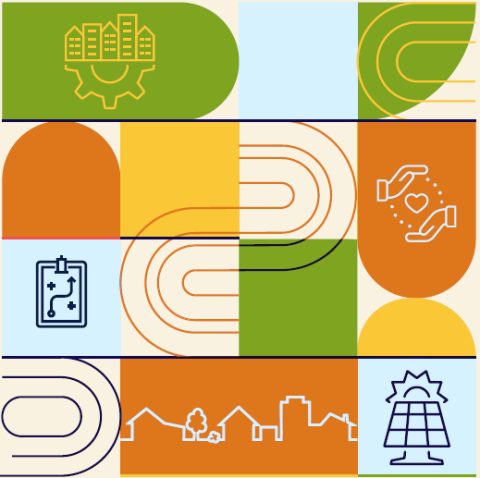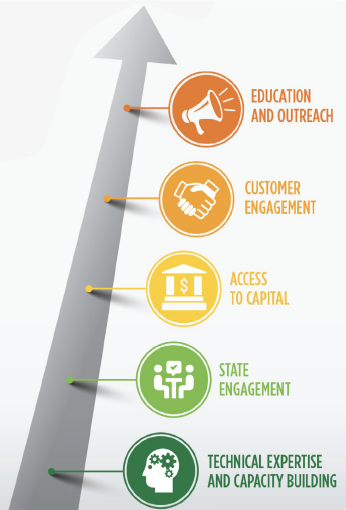
Project Readiness Questions
- Have you truly considered what the community needs, including their priorities when it comes to community solar?
- Have you considered who, how, and when to engage community members, how to build trust and garner support for your project?
- Do you have a plan for how to perform community engagement at all stages in the solar development process?
- Do you have project strategies to address NCSP’s five meaningful benefits, such as workforce development, resilience and storage, community ownership, and/or deep bill savings?
- Have you considered how to positively engage with the local electric utility?

Background
Developing mission-driven community solar projects requires building trust and working with community members by listening and learning about their needs, and ensuring the projects are responsive. As a result, community engagement should be incorporated throughout the development process, including site selection, subscription strategy, zoning and permitting, construction, and operation/offtake.
Obtaining stakeholder input can be time-consuming and costly for developers but it is necessary to ensure equitable projects. Robust communication with local residents, community-based organizations and city officials helps identify community needs and how to best achieve them. Community engagement can also help raise local awareness about solar energy and provide public education. Equitable community engagement must include the voices of those low-income residents who are often left out of the process. Keeping communities informed of all aspects of your community solar project ensures that local residents will be invested in the project and assist in its success.
The guide for Equitable Community Engagement in Community Solar by Groundswell says, “Community engagement should start early and move throughout the project planning process. Discussions should be recurring with multiple opportunities for community members to provide input as planning develops further. Engaging early on and consistently can gain community trust. Particularly, community members may not like the change in landscape when large solar arrays are installed. By enabling the community to voice their own ideas of how the project may benefit the community and explaining how the benefits could be realized can help ease opposition. As you plan your project, you will also want to identify the community networks, processes and key actors that may be useful in building and operating your project. The goal should be to build out project operations that leverage existing community resources and structures.”
It is important to include information learned from community engagement to decide on your project’s pricing model, which can be either a subscription or cooperative model, see chapter 7 for more details on these models. Information gathered through community engagement can be used to connect underserved and low-income communities with community solar subscriptions to efficiently lower the cost of customer acquisition, reduce low-income household energy bills, and increase the deployment of community solar projects. Additionally, by conducting intentional community engagement, developers can learn simple things such as how members pay their utility bills, what language is most spoken in the region, and how to best message bill savings, among other critical information to ensure strong community solar adoption.

If community engagement reveals that the community would like more ownership of the project, a developer could engage in a “cooperative” ownership model, which often relies solely on participants to fund the installation and maintenance of solar panels, storage components, and distribution infrastructure. Participants then receive solar net metering credits proportional to their investment in the community solar project. Once enough credits have accumulated to pay off a consumer’s initial investment, they continue to have access to power produced through the system they helped to finance.
Action Items
- Identify the decision-making power your community will have for the community solar project using the Spectrum of Community Engagement to Ownership Framework.
- Do a primary scan to learn about your community’s demographics. One easy way to access a variety of demographic data is to use Policy Map (which has both free and paid versions), or you can access Census data.
- Develop and engage in a community engagement plan. Using the background knowledge you collected about your community and the demographics, design a plan of action for engaging community members. Using the guidance provided in the Community Solar and Community Engagement Guide, develop a robust plan to gather community insights. For detailed questions to ask, see this community engagement planning tool.
Steps include:
- Learn about community engagement throughout the development process.
- Learn preliminary information about your community.
- Form committed community partnerships with organizations that are supportive of the work and have good relationships with other community agencies and citizens.
- Develop an intentional timeline that includes time invested in community trust building.
- Schedule learning conversations with local stakeholders in your community of interest to explore the possibilities for community solar development. Use the Community Equity & Low-Income Checklist to guide these conversations.
- Understand the needs and interests of the community that your project will serve and how a community solar project can respond to those needs and interests. Review the first section of the Community Solar Equity Checklist on “Planning” while completing the list of activities above.
- Determine a pricing model using lessons learned from community engagement.
- Consider pros and cons of Community Solar Cooperatives and Co-Benefits. Learn how to Build a Subscriber Pool through Community Engagement: Take the lessons that you learned from analyzing outreach results and use them to begin creating your program siting, design, financing, customer acquisition, and marketing plans. More information about Subscription Management can be found in chapter 7.
- Continually inform your community of the process and progress of your community solar project.
Eyes on Equity
Steps to take ensure that you reach LMI Communities in your Community Engagement Process
- Identify historically underserved communities and invite community members, community representatives, and community-based organizations to the conversation.
- Be intentional about when and where engagement events occur, and consider evenings and weekends to ensure strong attendance with flexibility to support the community needs.
- Compensate participants for their participation and expertise.
- Create a linguistically and culturally accessible engagement strategy that includes transparency and accountability to the community.
- Partner with communities to design and deliver programs: See the Clean Energy States Alliance’s Community Outreach and Solar Equity: A Guide for States on Collaborating with Community-Based Organizations for best practices and principles for developing relationships with community groups.
- Do not end your outreach once you have gotten initial feedback. As a part of your community solar project, continue to ask for feedback and talk to the customers you serve, especially LMI households.
Additional Resources
Engaging Community Partners
- Up to the Challenge: Communities Deploy Solar in Underserved Markets report provides insights from innovative projects that demonstrate that expanding solar access to underrepresented markets is economically feasible.
- Community Engagement Guide for Sustainable Communities describes the Sustainable Communities Initiative, where communities are catalyzing new networks of relationships, finding new problem-solving methods, and creating new inclusive decision-making tables to craft an authentic vision for an equitable and prosperous future.
Stakeholder Engagement
- Stakeholder Engagement | SolSmart toolkit provides different formats for convening and engaging stakeholders—This section of Solar Energy: SolSmart’s Toolkit for Local Governments provides guidance to municipal and county staff on how to develop and implement an engagement strategy.
